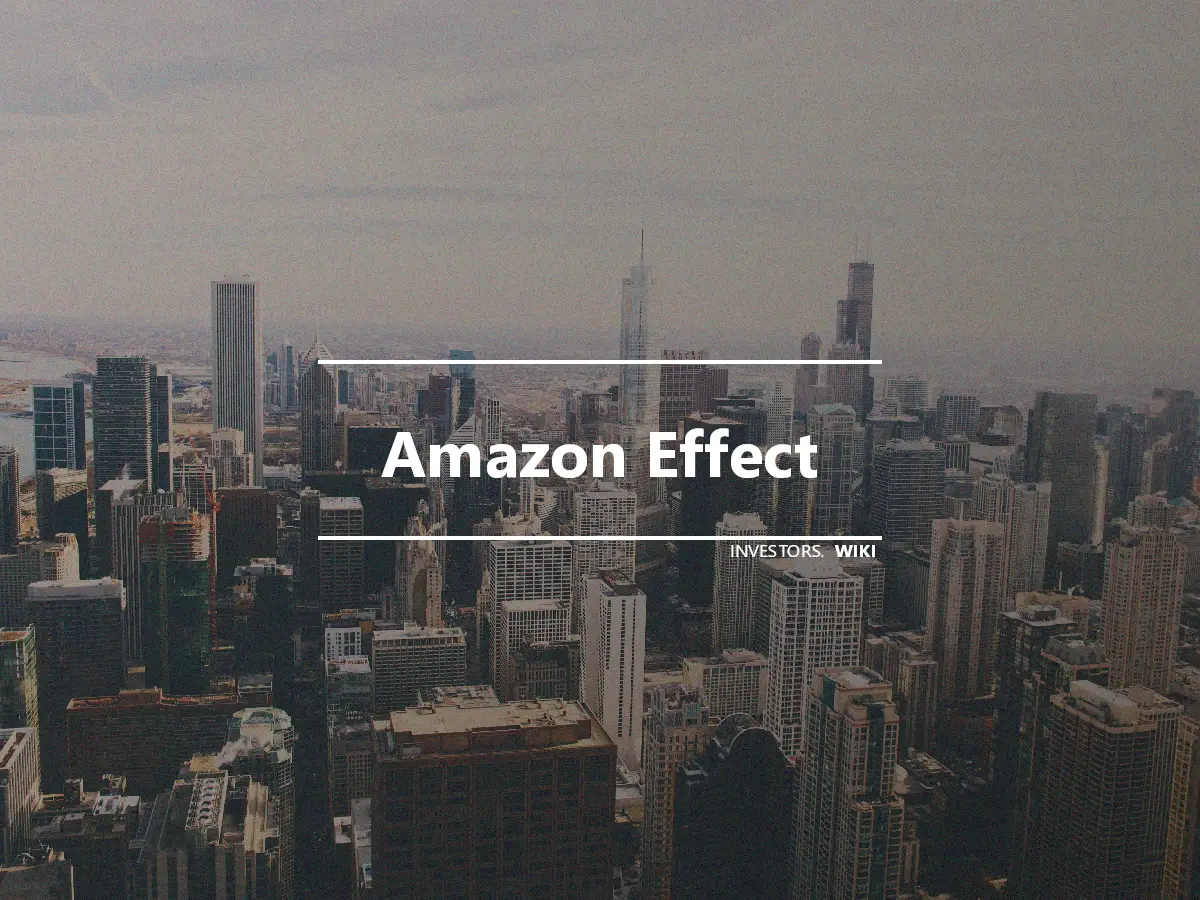Amazon Effect

What Is the Amazon Effect?
The Amazon effect alludes to the impact made by the online, eCommerce, or digital marketplace on the traditional brick and mortar business model that is the consequence of the change in shopping designs, customer expectations, and the business' competitive landscape. As online shopping and eCommerce fill in fame, it has harmed numerous traditional businesses that are forced to rival the online marketplace with just a physical location.
Understanding the Amazon Effect
As online shopping increases, the gains for internet business businesses are coming to the detriment of brick-and-mortar retail stores. A rising number of shoppers are setting out toward their screens rather than for stores; online sales represented 13.6% of retail sales in the U.S. in 2020, compared to 10.7% the previous year, as per the US Census Bureau.
Amazon.com Inc. (AMZN), which appeared in 1994, has maintained its lead in global online selling and has turned into the perfect example for this change, giving the Amazon effect its name. Among different factors, the Amazon effect is refered to as the primary justification behind the decline in brick-and-mortar store sales, which have frequently foreshadowed the stores' eventual closure. In excess of 5,300 stores closed in 2017, up 218% more than 2016.
Past raising a ruckus around town of traditional retail stores, the Amazon effect has likewise prompted massive changes in consumer shopping designs. For example, in view of the convenience they experience from online shopping entrances, the present shopper expects significantly more assortment even while visiting a retail store. While it may not be imaginable to plainly peruse the items or particulars referenced on a little measured pack containing an electronic contraption or cashew nuts in a retail store, a similar product details can be handily gotten to in large text on online shopping destinations. The consistent online shopping experience has likewise impacted the behavioral expectations of shoppers, as they presently anticipate a similar perfection, ideal response, and convenience even for services (like at a salon) that generally can't be offered online. Shoppers can likewise peruse remarks online, immediately perceiving how others feel about the product.
Benefits and Disadvantages of Online Shopping
The need to head to a store, pick out various things, and stand in line to purchase them is wiped out with online shopping. Purchasing a thing online could be cheaper than purchasing in a store (albeit this isn't generally the case).
Innovation fueled shopping entryways additionally permit a nearly better utility to customers, similar to a simple repeat of standard month to month staple orders. The utilization of big data and artificial intelligence (AI)- fueled systems that better monitor a customer's shopping example and behavior by means of online gateways are a shared benefit — the consumers get modified offers and advancements, and shopping entryways benefit by pitching products with a high probability of being purchased. These highlights are not available to traditional retailers or are costly. High real estate costs likewise put the retail stores in a difficult situation.
In the midst of rising fights from brick-and-mortar retailers across the globe, large online players are sending off drives to loop the former into their supply chains. For example, numerous online shopping entries permit online ordering with a pick-up option at a close by retail store. Store administrators benefit by getting a cut for their service, by supplying a couple of the ordered products from their own stores, and by an increase in foot traffic in their stores.
Customers buying online don't get to feel, see, hear, smell, or taste a product before they buy it online (except if they have previously utilized the product or they scope it out at a physical retail location before buying it online). Along these lines, physical and online shopping make a decent pair. Customers can cooperate with a product at a physical location however at that point order it online at their convenience, potentially at a cheaper cost.
While this is a decent pair for the customer, the brick-and-mortar stores endure. They pay the costs — workers, lease/leases, inventory, utilities — for customers to shop, however at that point the customer purchases the product online. This is risky for some consumers also on the grounds that as stores close, consumers can't communicate with products before they buy.
Special Considerations
The Future of Brick-and-Mortar Stores
The 2020 global emergency — where numerous residents confronted quarantines, remain at-home orders, and travel boycotts — exposed the significance of online shopping. For some, it turned into a necessity, instead of a luxury. However long the Internet exists, online shopping isn't probably going anyplace.
The number of individuals shopping online is expanding, which puts brick-and-mortar in a dubious position. To draw customers to a physical location, something should be offered that can't be delivered online. This could be an experience or an inclination individuals get when they visit the location. A few shopping centers offer amusement parks, cinemas, or a wide cluster of eateries to tempt individuals to spend the evening or evening at the shopping center.
Some retail outlets have flourished notwithstanding the increase in online shopping. This is on the grounds that they offer a unique or high-quality product that essentially isn't sold by online retailers or won't be quickly duplicated into a cheap imitation product (that can be sold online by others). Other retail chains have made a culture around their product and stores, where individuals like to proceed to seen go there. More brick-and-mortar operations will probably have to take on these types of strategies to flourish as online shopping keeps on having more market share.
Highlights
- The Amazon Effect is the disruption to conventional physical retail locations brought about by the increase in online shopping.
- Amazon is the biggest eCommerce website, so this disruption is in many cases called the Amazon Effect.
- Online shopping gives convenience and wide selection at frequently a decent price, yet the customer misses out on seeing and contacting a product before buying.
